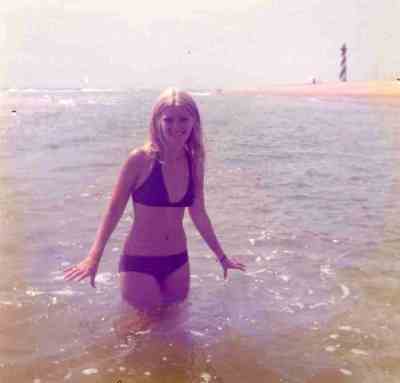
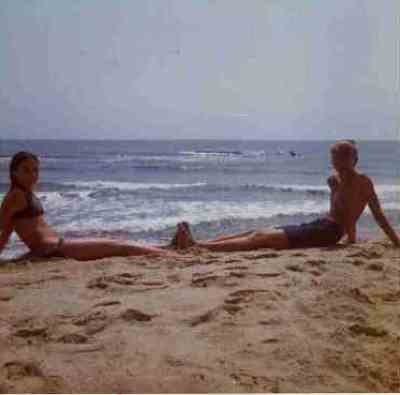
| Route 66 | Cities | Beaches |
 |
 |
|
Regardless of windsurfing, fishing, history, wildlife or restaurants, the reason people come to the ocean is The Beach. You go to The Beach every day and schedule everything else around it. And Hatteras is certainly blessed with beaches. Theirs are ranked the best in North America. With good reason. As was mentioned in the introduction, these are Natural Beaches. There are no grooming machines on the island. There are no boardwalks, hot dog stands, beach chair rental booths, floats marking swim zones, or nets out in the water to separate the ocean from the people. Nor do you pay to park or to walk onto the sand. You come to The Beach at Hatteras, you confront The Ocean on its own turf. You'll share the sand with Gulls, Pelicans and Ghost Crabs during the day, and if you come back after dark you can meet Horseshoe Crabs, Sea Turtles and Plovers. You'll share the water close to shore with Manta Rays, Jellyfish, Blues, Red Drum, and a dozen other fish. On the outside of the bars, you'll be joined by Porpoises and larger fish. A whale may come in close. Underfoot will be an assortment of shells. Portugese fishing nets with glass balls may wash up on shore. Shown at right is a jellyfish stranded by the ebbing tide. Even the sand is alive. These beaches change from short and steep to wide and level. The bar will drift closer and closer until it merges with the shoreline, and a new bar will appear way out and repeat the process. Every day The Beach is different. |
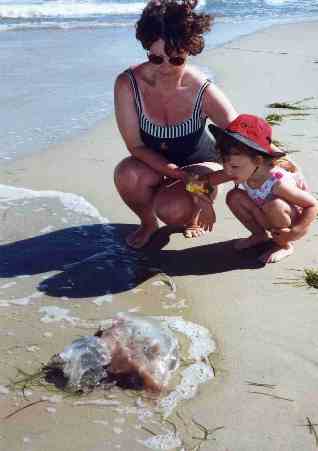 |
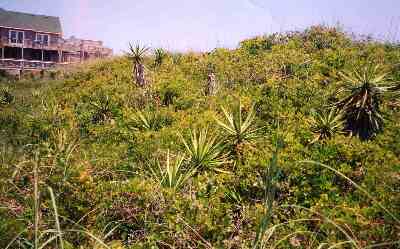 |
Hatteras beaches are backed up by huge dunes. The ones north of Rodanthe are pure sand and drift back and forth, continually trying to bury the highway, but the ones between Salvo and Frisco have a thick cover of a dozen kinds of grasses and shrubs and stay put, except from the Jetties south to The Point, where they taper down. Houses by law may not be built on the dunes. There are stairs and walks crossing over so your footsteps don't erode them. But the dunes play important roles. They protect the houses from the fury of the ocean. They provide nesting for birds, lizards and small mammals. They absorb storm tides like a cushion. They separate the saltwater ecology of the beaches from the freshwater environment of the interior. If you don't go North for any other purpose, drive up there just once to see what the dunes are doing. It's pretty spectacular but also scary. Nature is trying to reclaim that part of the island from Man. Keeping that road open has become a war, and for a day or so each week man is losing. Also notice the houses in North Rodanthe the ocean is reclaiming. |
| The Front Beaches (those facing due East along the North-South arm of the island) tend to be wide, gradual, with a trough close to shore, then a shallow bar. At high tide you may need to swim a few strokes, but it is still easy to get out to the bar. At low tide you can wade all the way. Day by day, the bar will drift, so the trough is wide one week and narrow the next. This is a huge advantage, because kids can play in the trough somewhat protected from the full power of the ocean, although the waves cross the bar with enough strength left to break pretty well on shore. Older kids and adults usually spend their time on the outer edge of the bar, where they can confront the full size and power of the incoming waves. Surfers and surfyakers play out beyond the bar. In the photo at right you can see fairly deep water in the trough, then people out on the bar in waist deep water. Way out there you can see a few people in deeper water. The South Beaches (those facing South along the East - West arm of the island) rarely have a bar, because the Gulf Stream keeps the sand moving toward the inlet. | 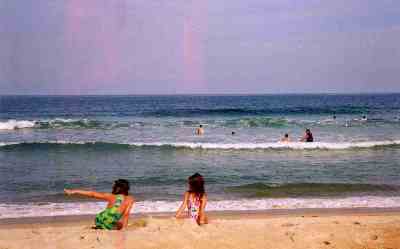 |
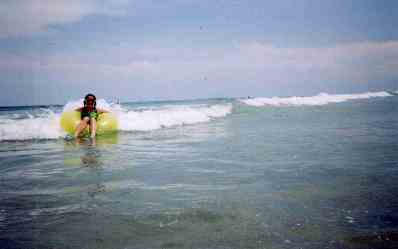 |
Tubing is a beach sport on Hatteras. You can bring one with you or buy them here. But there are two ways to tube and you need to buy the proper size. If you plan on tubing between swimming or surfing sessions, so you will mainly be relaxing, then you'll drop into the trough, floating with your arms draped over the tube. As the waves come in, you will then rise and fall. It's a great way to spend an hour, but you need a tube which fits rather snugly around your body, so you don't have to use energy to hang on. Too big a tube will mean you have to keep pulling yourself back up and this will not be a relaxing float. On the other hand, if you plan on tubing as a form of surfing, going out beyond the bar, catching the crest of the incoming waves and riding them across the bar and in to shore, then you need a tube big enough to sit your butt down in and drape your legs over one side while you lean back against the other. Buying a tube too small will guarantee you keep getting dumped by the wave. Back home the inner tubes and "river rat tubes" may not be available in the right sizes. |
| Rip Tides are an issue on the Front Beaches. They're always a danger, but in all the years we've been coming we've only had one incident. The bars cause the rip tides. The incoming waves pile water up on the beach and it has no where to go, since the bar blocks its path. So every so often, there will be a break in the bar. Water will flow sideways along the trough, then flow back out through the break. If you happen to step or swim into the break, all of a sudden you're caught in a strong current pulling you out to the open ocean. An adult who is a good swimmer is usually ok, but a little kid or a weak swimmer can be overpowered. To deal with this, in our meeting with the kids back at the house, we explain that as soon as we get to the beach, nobody goes in the water until we have time to walk up and down and determine where the nearest center is and where the two breaks are. We point out obvious landmarks -- usually a beach umbrella or sand castle -- that line up with the breaks. Then we pitch our blankets and chairs halfway between the two and send everybody into the water there. We teach our kids that if they feel a rip current pulling them, to swim parallel to the shore back to the bar. We also alert our older kids to keep an eye on our younger kids and prepare to help if needed. Our surfers actually use the rip tides. They ride the waves in to shore, then ride the rip tides back out beyond the breaker line. It saves them a lot of exhausting paddling. So they're usually pretty close to the breaks. The one incident we had was when one person got caught and carried out. He was swimming hard, but losing the battle. One of our surfers quickly moved across, picked him up, and rode him back in to the bar. There are enough surfers, bodyboarders, surfyakers and swimmers out beyond the bar that somebody is always available to help. And when we say the water flows sideways along the trough, that is a gentle movement and not a problem. As a matter of fact, it allows kids to put an inner tube in the trough and ride the drift, pulling out just before the break. As long as we have adults in the water keeping an eye on things, this is fine. Rip Tides are more of an issue at low tide, because at high tide the excess water can easily pass back over the bar. But at low tide there's less water to deal with. So the problem tends to resolve itself as long as everyone pays attention and uses a little caution. | 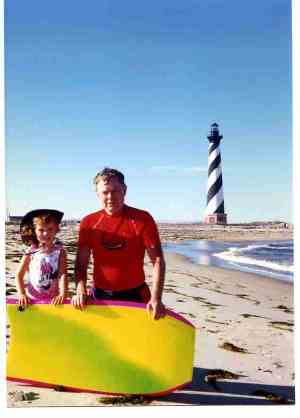 |
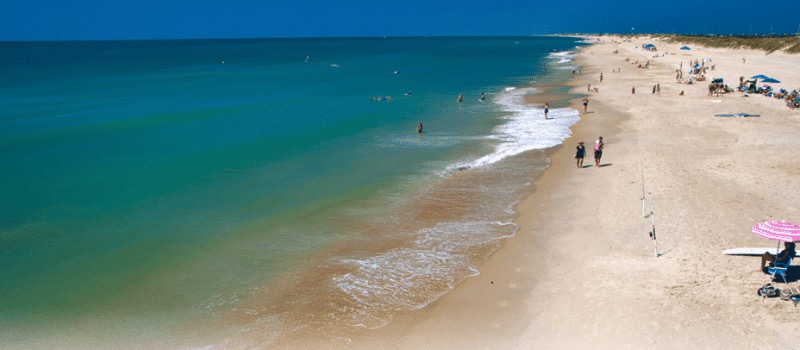 |
Which beach to go to is a hard choice. All the Front Beaches are ranked. Buxton Beach (left ) has been the #1 beach in America for a century. A shallow shelf extends far out, allowing waders to play in waist deep water with waves big enough to be exciting but not so large as to be dangerous. Buxton Beach usually has a classic bar and trough profile. The beach itself is wide and you'll be joined by Ghost Crabs, Gulls and Willetts, which are endlessly entertaining. Porpoises play in the water off shore. This beach ws completely rebuilt in 2020 after severe hurricane damage. This is a great tubing and bodyboarding beach. |
| Avon Beach (right) is longer, more gently sloped, and extends three miles along the front of the town. It's a good beach, attracting the most people but having the most room to spread them out. Teenagers like it because they can strut up and down looking and being seen. The bar tends to be medium distance and the trough about waist deep at low tide. Rip tides are fewer and sometimes absent. We recommend the lot at the southern edge of town below the large house signed "One," the parking area at the miniature golf course and fishing pier in the center of town, and the turnout just at the northern side of town. Rest rooms are also a problem here because almost everybody using the beach walks down from their rental house and goes back there as needed. There are restrooms at the fishing pier.At the southern lot, there are restrooms across the road and up a few steps at the Canadian Hole launching beach. The fishing pier also has a concession stand. North, you have to walk or drive across and down for concessions. There is a convenience store half a block north of the southern lot. | 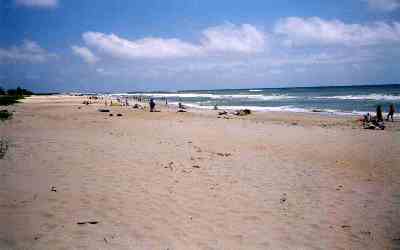 |
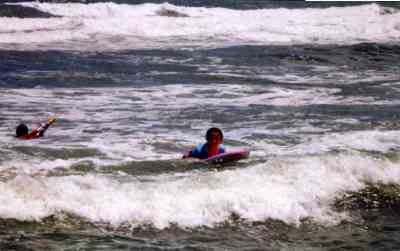 |
Frisco Beach appeals to many. It has lifeguards from June 1 to September 1. It's back along the Gulf Stream so water is 8-10 degrees warmer. Often, when the surf is intense along the front beaches, the South facing water is calmer at Frisco. There is a large parking area, showers and rest rooms. Just up the beach the Frisco Pier has concessions. Due to lateral currents here, Frisco does not have the bar and trough profile of the front beaches. Once the water deepens, it never shallows back up. If you have kids or weak swimmers, this is a consideration. Shelling at Frisco turns up Gulf shells. If you take your sand sculpturing seriously, the sand along the South beaches is a little coarser than that on the Front side. Sometimes this can be an advantage. Often it can be a disadvantage. Just down from Frisco Beach was where Hurricane Isabella punched through the famous Isabella Inlet, making Hatteras Village an island for two months. They've repaired that gap now, but in the process a lot of mud accumulated offshore, so the water here is slightly dirtier. It's slowly clearing up. |
| Lighthouse Beach for a decade rated the number one natural beach in the nation. It lays just South of Iron Jetty Beach. Lighthouse has the largest parking lot, lifeguards after July 1, and restrooms. It does not have the high dunes of the rest of the island, as the sand is levelling down nearing The Cape, just to the South. But it is a long, gently sloped beach, with the best trough and bar profile on the island. One advantage we like is we can bring our group and surfers can spend their time 100 yards north at Iron Jetty. We see everyone but they do their own thing. This is also where the surfing, surfyaking and bodyboarding instruction is done, so if we enroll anyone in those programs we bring everyone to the same place and farm them out to their instructors. It saves driving all over the island. Often we'll have students finish their instruction, then come on down the beach and spend the rest of the afternoon swimming with the group. This is the best inner tubing, bodyboarding and surfyaking beach on the island because of the long sustained breaking of the waves. You're getting pretty close to The Cape, so the water is a few degrees warmer here than at Avon or Rodanthe. | 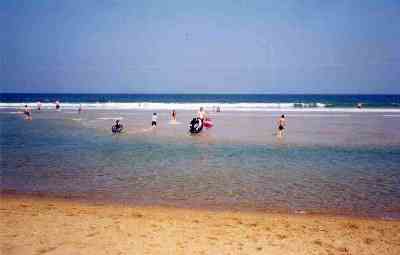 |
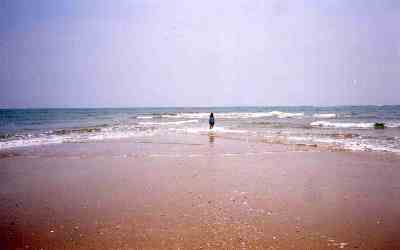 |
The Cape is famous for surfcasting and shipwrecks but it is also a great beach. To get there, you need a long hike. A parking area puts you within a mile and you can hike down the beach. At left, the swimmer stands with one foot 10 degrees warmer than the other as the Gulf Stream flows in from the right (South) and the Labrador Drift flows in from the left (North). This is a place for wading, playing in the shallows and shelling, but is not a place to try surfing, surfyaking, or even swimming very far out. The swirling currents are treacherous beyond these little coves. | 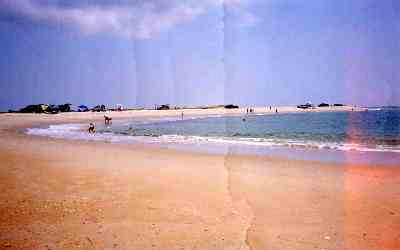 |
|
|||
|